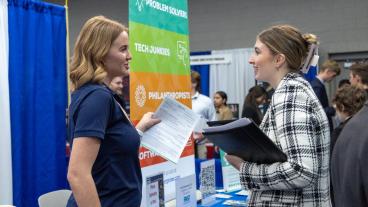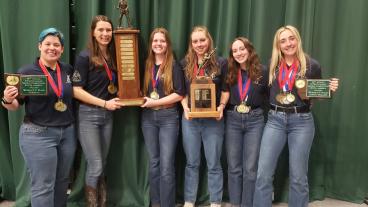Students from Colorado School of Mines took first place in the 2018 Applied Collegiate Exoskeleton Competition, beating out teams from four other universities in the first-time event held May 5 at the University of Michigan.
Exoskeletons – powered mechanical suits that augment the wearer’s strength and abilities – could be used in the future to improve mobility for people with disabilities, help airport baggage handlers lift heavy bags or assembly line workers handle repetitive movements.
For the competition, students focused on firefighters. Their challenge was to design a strength-augmenting robotic exoskeleton (STARX) to help bear the load of 75 pounds of firefighting equipment.
After a design review, where safety components and the time it took to suit up were assessed, the load-bearing leg exoskeletons and their operators were fitted with 75 pounds of weight and timed while moving through an obstacle course designed to simulate the difficult terrain likely to be found in an emergency situation: a balance beam, up and down stairs, across uneven terrain, under a low-clearance beam and dragging a 165-pound mannequin for 100 feet.
The Mines Robotics Club narrowly beat out the host university team – by just 0.09 points. Other schools sending teams to the competition were Michigan State University, University of Nebraska Omaha and Iowa State University.
“What set us apart, in my opinion, was our mobility,” said team member Stav Wine, a sophomore studying mechanical engineering. “We used ball joints on the hips of the exosuit so we could move almost as easily in the suit as without it.”
The victory didn’t come without its share of challenges, though. The night before the competition, the Mines team accidentally shorted its Arduino during testing, incapacitating the linear actuators that would have fully powered the suit. It forced them to compete with just the suit using springs for support, Wine said.
But the malfunction didn’t end up hurting them too much, as none of the teams were able to present fully functional suits, she said. Also on the Mines team were John Petryk, Tyler Zudans, Sebastian Cabrol, Eduardo Arellano Mendiola, Zach Smeton and Thomas Perry.
“Personally, I knew nothing about exoskeletons or bipedal robotics before going into this, and I feel like I've learned a lot,” Wine said. “Going in, our team's goal was to make a fully assistive robot but we ended up competing with a non-powered partially assistive bot and it worked great. After going through one of these competitions, we feel much more prepared for the next one and have tons of new ideas for Squibby Jr., next year's model.”
Photo credit: Courtesy of University of Michigan
CONTACT
Emilie Rusch, Public Information Specialist, Communications and Marketing | 303-273-3361 | erusch@mines.edu
Mark Ramirez, Managing Editor, Communications and Marketing | 303-273-3088 | ramirez@mines.edu



